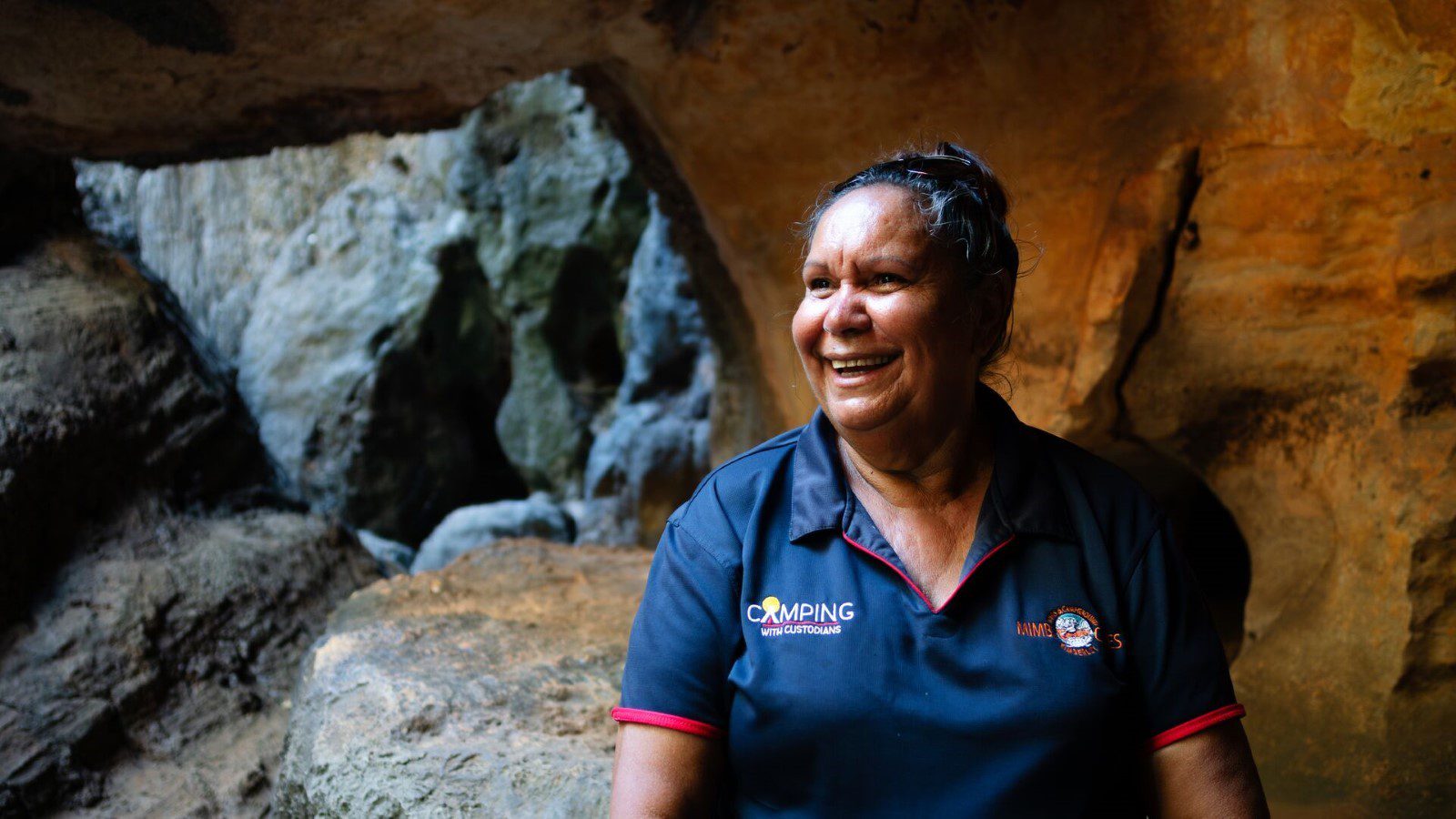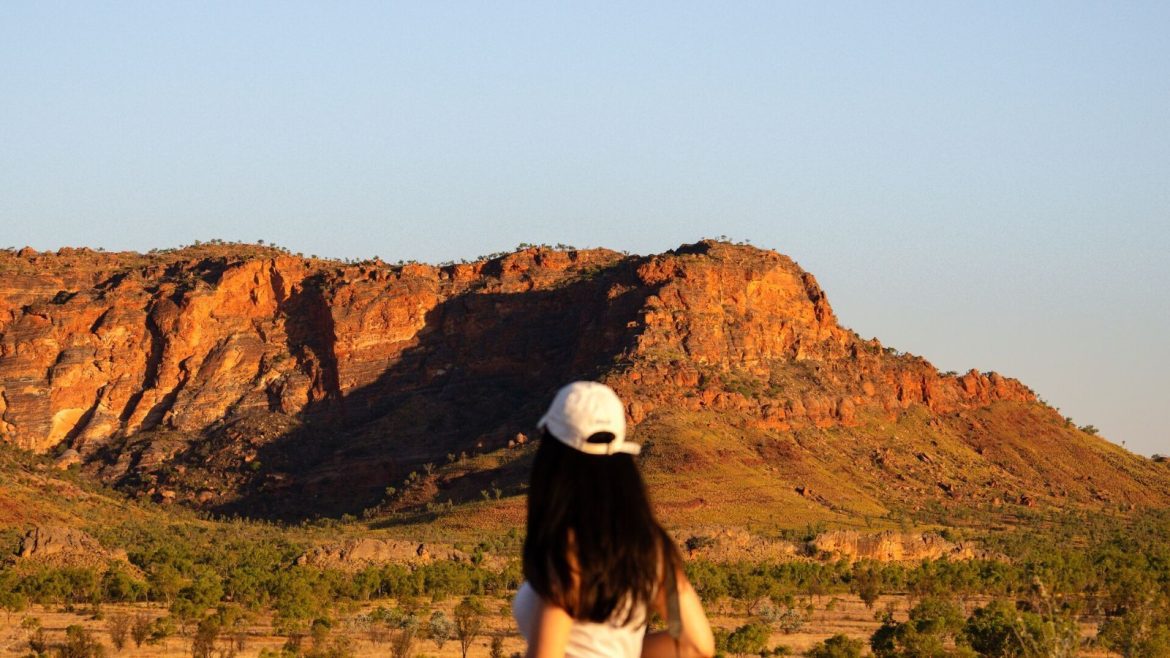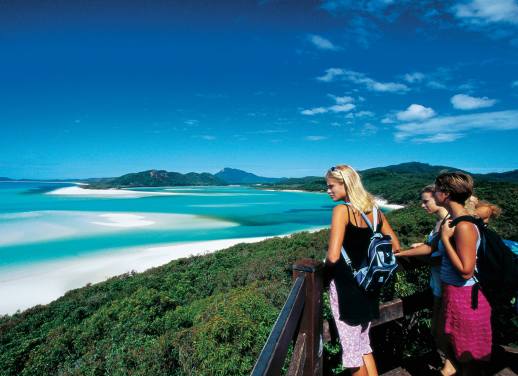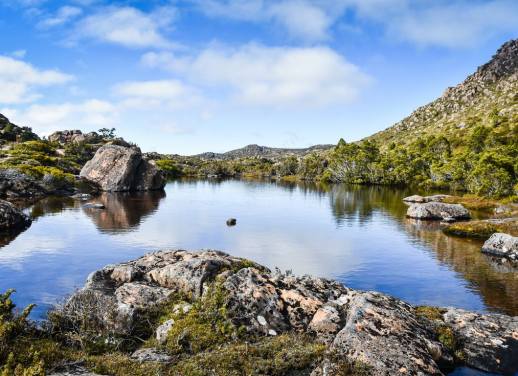On a revelatory trip to the Kimberley in Western Australia, Caterina sees her homeland in a whole new light.
Perhaps the best-known poem in Australian history was written by Dorothea Mackellar. The young Aussie moved to London and wrote Core of My Heart out of homesickness. It was published in Britain’s The Spectator in 1908 and made waves that reached Australia’s shores.
Its second stanza is its most famed:
I love a sunburnt country,
A land of sweeping plains,
Of ragged mountain ranges,
Of droughts and flooding rains.
I love her far horizons,
I love her jewel-sea,
Her beauty and her terror –
The wide brown land for me!
I heard these words growing up, but as someone born and raised in the city of Melbourne, they never really resonated with me.
As I soared over the Kimberley, Western Australia, that was all about to change. It’s one of the most remote and untouched parts of the country – sunburnt, ragged and full of far horizons.

Into a sunburnt country
Looking out the plane window, I gasp as I see my first ever red dirt road – an iron ore icon. The view is quintessentially Australian. But it’s also foreign to me.
The thought makes me pause. Am I homesick for parts of my own country?
We younger Aussies have a reputation for travelling overseas the first chance we get. We often overlook domestic adventures in favour of trips abroad, heading to the likes of Fiji, Japan, Indonesia and Vietnam to soak up different cultures, try unfamiliar foods and experience new sights and sounds.
But my five days in the Kimberley reaffirmed that we have all that right here at home. So why do we love to run far – literal oceans – away?
For the adventure, of course. But there’s more to it than that. The truth is, I’ve always wanted to travel to remote parts of Australia, but it can be an overwhelming, expensive endeavour. Then there are the long drives, often through demanding terrain – and I’m no four-wheel driver.
Joining a group trip can help with all that.
We’re not in Kansas any more
This is my first Intrepid trip – a five-day Broome to the Bungle Bungles adventure. We hop in an overland truck, custom-built for four-wheel driving and handling the Kimberley’s ruggedness. Heading east from Broome, we’re met with increasing sparseness as the kilometres tick by. The sun beams down on the red-orange earth and the resilient wild grasses that survive it. The few hours looking out at this unchanging terrain prove meditative.
I spot my first ever boab tree. They’re only found in this part of Australia, the Indian subcontinent and parts of Africa. Suddenly, they’re everywhere. How the boab got here is a bit of a mystery. One theory is that its seeds floated over the Indian Ocean but some scientists contest that, saying the seeds can’t have survived such a lengthy trip.
We pull over to view an enormous boab up close. Our leader, Sylvia, tells us this one is over 1000 years old. We touch its trunk and eat a boab nut – chalky yet sweet. The tree is so giant that we can step into its hollow centre, a space about two square metres big. You could probably sleep in it.

As I emerge from the tree’s belly, I realise I’m not in Kansas anymore. That this is a trip that will stay with me.
Driving past the charismatic boabs, they’re becoming my favourite tree. I also notice vibrant, puffy purple flowers popping out of the earth in abundance. Sylvia tells us their Aboriginal name: mulla mulla. For thousands of years, Australia’s First Peoples have used native plants as what is called ‘bush medicine’. Many of Australia’s native plants have antibacterial and anti-inflammatory properties. Mulla mulla do not. They cannot be eaten or used as medicine. Sylvia explains that their name translates to ‘beautiful but useless’ – a comical description of a flower with no practical benefits.
I wish we had a word like mulla mulla in English. Across the Kimberley, there are about 200 Aboriginal communities and 55 languages spoken. Whenever I learn a word like mulla mulla, I’m reminded of how important it is to preserve endangered languages. Once they’re extinct, they’re near impossible to revive. And with their loss comes the loss of understanding key parts of history and rich, ancient cultures. And humour – now I can call something a mulla mulla in my head and giggle.

Campfires and connections
Driving into Purnululu National Park temporarily turns the truck into a rollercoaster. The road is full of potholes and steep inclines. Our other leader and driver, Gareth, safely and expertly makes it through, all while giving us facts about the park and letting us know what’s to come over the next few days.
Purnululu National Park is home to the celebrated Bungle Bungles, a vast range of unique cone-karst rock formations. Australia’s First Peoples had long known of the Bungle Bungles, but settlers didn’t discover them until the 1980s. Amazing, really, considering they span 450 square kilometres.
We arrive at our camp. Night descends and we settle around an epic campfire. The group gets to know each other more. Everyone lives in Australia. Some have extensively travelled around the country, others not so much. In a short amount of time, we have become a chatty, connected group.
The next day, we drive closer to the Bungle Bungles themselves and walk among them, engulfed by the towering, otherworldly sandstone structures. I’m served a healthy, humbling dose of feeling tiny and frankly insignificant.
As we enter Cathedral Gorge (accessible by foot in the dry season when it’s not filled with water) Sylvia advises us chatterboxes to stop talking for a little while and lie on the earth. We comply and it’s the best advice ever. I pause, find my breath and admire the ochre amphitheatre, its enormous sandstone walls meeting a cloudless sky. The deeper into this trip I get, the more human I feel – afforded by a strong, unrushed connection to nature.


After a few days in Purnululu National Park, we drive to Mimbi Caves, an area that’s been inhabited by Aboriginal communities for more than 40,000 years. Our guide and local Gooniyandi woman, Rose, teaches us about her ancestral land and Aboriginal ‘kinship’ – that is, how a person fits into their family and community. Her opening line:
‘We don’t marry our cousins like the royal family.’
We erupt in laughter.
Rose has caught our attention and she keeps it. As a journalist, I know that to an extent, you can study how to tell stories. But some people just have it. And Rose certainly has it. She proceeds to explain the rules about who you can and can’t marry while drawing an accompanying diagram in the dirt at her feet.
Rose then leads us through the caves, which have served as a place of shelter, spiritual sanctuary and childbirth. They’re full of sparkling crystals, shimmering pools, stalagmites and stalactites. I feel honoured to be here with a Traditional Custodian of the land.
As we exit the cave system, Rose shares her personal story of how her family – and countless other First Nations families – worked for European settlers as a result of colonisation and forced displacement. They worked for no wages, Rose says. Only sometimes were they given rations of tea and sugar.
‘I’m so sorry,’ an older, white Australian man says to her. Rose thanks him.
It’s a poignant moment. Rose’s story – and her candid storytelling – has captured our attention, unlocked new levels of empathy and connected us to a shared history.
Moments like this are perhaps my favourite thing about travelling. After all, we don’t travel because we know it all – right? And I’m yet to know just how much more my home country has to offer.
Before this trip, my homesickness for my own country was subconscious. But now it has been well and truly brought to the surface. I love this sunburnt country now more than ever.
Caterina travelled on the Broome to the Bungle Bungles trip. See more of the wide brown land for yourself on one of Intrepid’s Australia trips.




